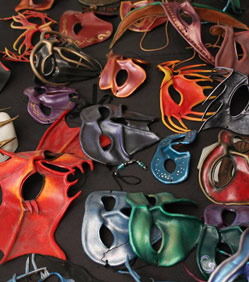 Source
Source
Published on October 29, 2014, Seven Days Newspaper
Plenty of fright fans have dressed up for Halloween as Leatherface, the gruesome villain of The Texas Chain Saw Massacre. But how many have worn an actual leather mask?
It’s no picnic to craft one, as native Vermonter Eric Roy could tell you. More than a decade ago, when he was working as the art director of a musical theater production of John Milton’s Paradise Lost in Laguna Beach, Calif., Roy picked up an unusual artistic passion: creating hand-tooled leather masks. (And unlike Leatherface’s, they’re not made of human skin.)
“For the angels and demons, we wanted something that would separate them from the mortals in the piece,” Roy remembers. A local artist, called in to create masks for those characters, gave Roy a crash course. Soon, Roy was experimenting with the scraps of leather the artist had left behind.
“I just kind of fell in love with the material,” he says. “I’d done some work with papier-mâché and sculptable plastics, and it didn’t really enthuse me. But as soon as I started playing with this, it was kind of like coming home.”
“This” was vegetable- or oak-tanned leather, which is relatively malleable while wet but extremely rigid when dry. The mask-making process that Roy learned was intensive: He’d hand-cut the leather, then wet it and massage it to fit the contours of a customer’s face, a process he had to repeat several times. It took hours to create a single mask — even before he added decorative designs, paint or surface treatments.
“It’s been parked in the hobby space [for years],” Roy admits. “The templating stages would take several hours. I’d be hand-cutting pieces with an X-Acto knife, so there were limitations in terms of how intricate the designs could be. Given the cost of the material as well as the time that went into it, it was never something that I could sell and charge adequately for my time.”
These days, though, Roy is churning out masks at a much faster rate. As the October artist-in-residence at Burlington’s Generator maker space, he’s been taking advantage of new technologies such as a laser cutter and 3-D printer.
“I was able to overhaul a decade-long process in a few weeks,” Roy says. Now he uses the laser cutter to eliminate the hours spent hand cutting, and digitally etches patinas and other intricate designs onto his masks. All told, he’s cut his production time by two-thirds, to the rate of one mask per hour, “while enhancing the quality of the finished product.”
Roy started hanging out at Generator as a volunteer and soon became a studio member. During parts of his residency, he admits, he was there at all hours. And not just for the machines but for the maker community. “The peers that I have [here] are able to temper me and sharpen me in ways that are going to propel me forward,” Roy says.
That’s exactly the goal of residencies in the maker space, says former executive director Christy Mitchell, who launched the maker-in-residence program at Generator in June. (Mitchell, who’s also the owner and creative director of S.P.A.C.E. Gallery on Pine Street and a mixed-media artist, turned the reins of Generator over to Lars Hasselblad Torres last Friday.)
“[Roy] was able to expedite his process completely, to the point where he’s going to be able to start a company,” Mitchell notes. So far, seven businesses have formed under Generator’s roof, crafting products such as drones, puzzle maps and buildings.
“That’s what excites us,” Mitchell continues. “And it doesn’t just excite us, it excites the state; it excites the local government as well, where they’re realizing, Wow, Generator’s not only super cool and fun to talk about, but it’s actually generating jobs.”
As for Roy, he has no employees yet, but he has plans to tap into local and regional theater and events markets. Next year, he hopes to capitalize on the spooky season. Perhaps he’ll even craft a literal “Leatherface” for some future Halloween.
